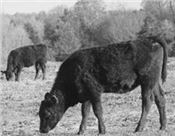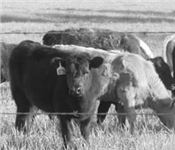Adding Weight To Stockers
ELDON COLE
MT. VERNON, MO.
Persons running stocker steers or heifers usually want them to gain weight and the more the better. A typical target in southwest Missouri is for them to gain at least two pounds per day. Most stocker operators buy in the 500 pound range and sell at 800 to 900 pounds.
Let’s say they’re shooting for adding 350 lbs. That means they’ll need to own them 175 days or 5.5 to 6 months. If you’re running on Kentucky 31 fescue that’s producing ergovaline and other ergot alkaloids you’ll have a hard time achieving that gain. Realistically, without supplements or other forages you’ll be lucky to sustain 1.75 lbs. per day on steers and even less on heifers. In mid-summer, gains can fall below 1.0 lb. per day.
Daily gains are influenced by genetics and the environment or day-to-day management. If you’re buying stocker calves or yearlings you can’t do much from a genetic standpoint to influence their gain unless you know the source. Otherwise, you figure they’re just average or maybe below in growth rate.
If you take the time to weigh the calves/yearlings individually you find out there can be a daily gain difference of a .5 lb. to 1.5 lbs. or more over the 175-day growing period.
If you’re wanting to boost gains you need to study your management practices. These practices come with a price so push the pencil for both quick-fixes and longer-term improvement.
The long-term remedy to the Kentucky 31 toxicity dilemma may be to renovate a portion of your pasture to a novel fescue or other forages that give your cattle relief part of the grazing season from toxins. The most mentioned forages to give cattle toxin relief for a reasonable cost are legumes. They are good at diluting the toxin and are reasonably easy to inter-seed if you follow the recipe book to the letter.
Now, let’s look at some less extensive and expensive management practices. The first one I’d consider are growth promoting implants. The costs vary from $1.50 to $3.50 per head depending on the product, your supplier and its length of activity. An implant program should boost daily gains, when nutrition is adequate by 0.2 to 0.3 lb. per day. The only excuse not to use implants is if you have a special market that pays a premium for no hormones used.
Other additives that boost performance efficiency are the ionophores. They come in various forms and usually are blended in a supplement. The ones used most are Rumensin and Bovatec.
Speaking of supplements, that’s almost a necessity when you’re shooting for 2 to 2.5 lbs. per day gain. We usually see at least 3 to 5 lbs. per day of an energy supplement being the target. If forages are in short supply one percent of the animal’s body weight in intake could be the target.
Supplements that have been popular for several years are by-product feeds such as soybean hulls, corn gluten feed, dried distillers grains, wheat midds and of course corn. Recently, the reduction in ethanol production has increased the cost of distillers grains so they may not be as cost-effective as other feeds.
The method of feeding supplements varies from operation to operation. Hand feeding daily in feed bunks still is effective. Alternate day feeding in bunks is used by some. Cubes fed on the ground work and there are numerous self-fed forms of supplements and the use of salt to limit intake is a long-time option if you have self feeders.
Additional products that show improvement in daily gains are internal and external parasite controls. Consult your veterinarian about products that are working in your community. Pasture rotation, as in management intensive grazing, is a proven management practice to enhance pasture quality. Certainly, it can enhance legume establishment in toxic pastures. It’s very important to make sure pasture growth is adequate so the stockers can get their fill of pasture easily. The optimum forage height is 4 to 8 inches for grazing.
The bottom line is a stocker program has numerous practices that can boost daily gains. Most are cost-effective but you need to look at cost and convenience.
I recall asking some producers why they were successful with getting good gains on stockers and they said, “look them over every day.” That’s an advantage to feeding and counting them on a daily basis. ∆
ELDON COLE: Extension Livestock Specialist, University of Missouri

Desirable forage height of 8 inches.

Forage height will limit dry matter intake and daily gain. Should not be able to see dew claws.